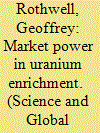|
|
|
Sort Order |
|
|
|
Items / Page
|
|
|
|
|
|
|
| Srl | Item |
| 1 |
ID:
117322


|
|
|
|
|
| Publication |
2013.
|
| Summary/Abstract |
This paper analyzes the causes, responses, and consequences of the Fukushima nuclear power plant accident (March 2011) by comparing these with Three Mile Island (March 1979) and Chernobyl (April 1986). We identify three generic modes of organizational coordination: modular, vertical, and horizontal. By relying on comparative institutional analysis, we compare the modes' performance characteristics in terms of short-term and long-term coordination, preparedness for shocks, and responsiveness to shocks. We derive general lessons, including the identification of three shortcomings of integrated Japanese electric utilities: (1) decision instability that can lead to system failure after a large shock, (2) poor incentives to innovate, and (3) the lack of defense-in-depth strategies for accidents. Our suggested policy response is to introduce an independent Nuclear Safety Commission, and an Independent System Operator to coordinate buyers and sellers on publicly owned transmission grids. Without an independent safety regulator, or a very well established "safety culture," profit-maximizing behavior by an entrenched electricity monopoly will not necessarily lead to a social optimum with regard to nuclear power plant safety. All countries considering continued operation or expansion of their nuclear power industries must strive to establish independent, competent, and respected safety regulators, or prepare for nuclear power plant accidents.
|
|
|
|
|
|
|
|
|
|
|
|
|
|
|
|
| 2 |
ID:
092916


|
|
|
|
|
| Publication |
2009.
|
| Summary/Abstract |
Four firms dominate the international uranium enrichment market. Simultaneously, the nations that host enrichment facilities strongly discourage other nations from developing enrichment capacity, given its potential use in nuclear weapons production. Therefore, these four firms benefit from the exercise of national power to prevent entry into this market. This paper shows that these firms also benefit from increasing returns to scale. In similar national situations, this industry would be regulated or nationalized. This is because free markets do not necessarily lead to a socially optimal long-run equilibrium where the industry is necessarily concentrated, such that there is no proliferating entry, but is sufficiently diverse, so that no one national group can dictate prices, contract terms, or non-proliferation policy. Therefore, some form of international regulation might be necessary to discourage enrichment technology proliferation and assure enrichment supply at reasonable prices.
|
|
|
|
|
|
|
|
|
|
|
|
|
|
|
|
| 3 |
ID:
177412


|
|
|
|
|
| Summary/Abstract |
Irradiated or Spent Nuclear Fuel (SNF, where it could be “used nuclear fuel” if reprocessing facilities are available) is periodically removed from nuclear power reactors and allowed to decay in suitable storage facilities. This paper attempts to calculate the relationships between sizes and costs of wet/dry and onsite/offsite SNF storage. The methodology is (1) to propose cost models based on publicly available data and (2) to estimate cost equations to compare the various storage costs. When the fuel pool nears capacity, the cheapest alternative is to transfer SNF to onsite dry storage. Once a nuclear power plant has been decommissioned, and only the onsite dry storage facility remains, there appears to be little economic reason (from the nuclear power plant owner/operator’s viewpoint) to move the SNF to consolidated facilities because of extra monetary and non-monetary costs. Unless there are explicit national policies and funded programs to manage SNF, there are likely to be legacy sites with stranded SNF. On the other hand, there is a consensus that consolidated facilities (1) would be more safe and secure than dispersed onsite storage locations, (2) would facilitate final disposal, and (3) might reduce the risks perceived by local communities of storing SNF.
|
|
|
|
|
|
|
|
|
|
|
|
|
|
|
|
|
|
|
|
|